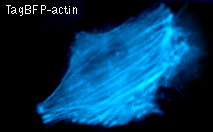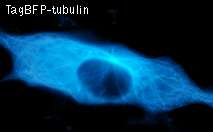
|
||||||||||
|
||||||||||

TagBFP
SUPPORTRESOURCES |
Blue fluorescent protein TagBFP- Bright blue fluorescence Performance and useTagBFP can be easily expressed and detected in a wide range of organisms. Mammalian cells transiently transfected with TagBFP expression vectors produce bright fluorescence in 10-12 hrs after transfection. No cytotoxic effects or visible protein aggregation are observed.
TagBFP performance in fusions has been demonstrated in the High pH-stability with pKa=2.7 makes it possible to use TagBFP for imaging in acidic organelles, such as late and recycling endosomes and lysosomes.
Emission spectrum of TagBFP and absorbance spectra of GFPs demonstrate good overlap, suggesting TagBFP may be a good donor for GFP acceptor for Forster resonance energy transfer (FRET). Among available GFPs, TagGFP2 is prefferable because of the small absorbance below 400 nm where TagBFP is excited. High efficiency of TagBFP-TagGFP2 FRET pair was demonstrated in living cells [Subach et al., 2008]. References:
|
|
Copyright 2002-2023 Evrogen. All rights reserved. Evrogen JSC, 16/10 Miklukho-Maklaya str., Moscow, Russia, Tel +7(495)988-4084, Fax +7(495)988-4085, e-mail:evrogen@evrogen.com |





